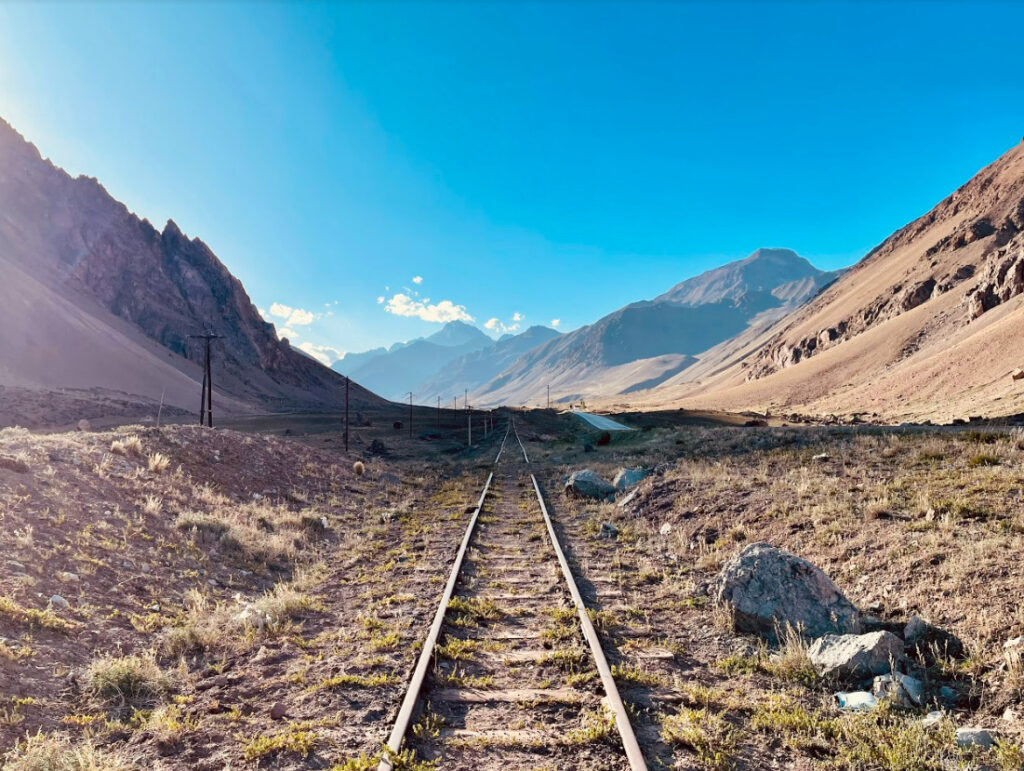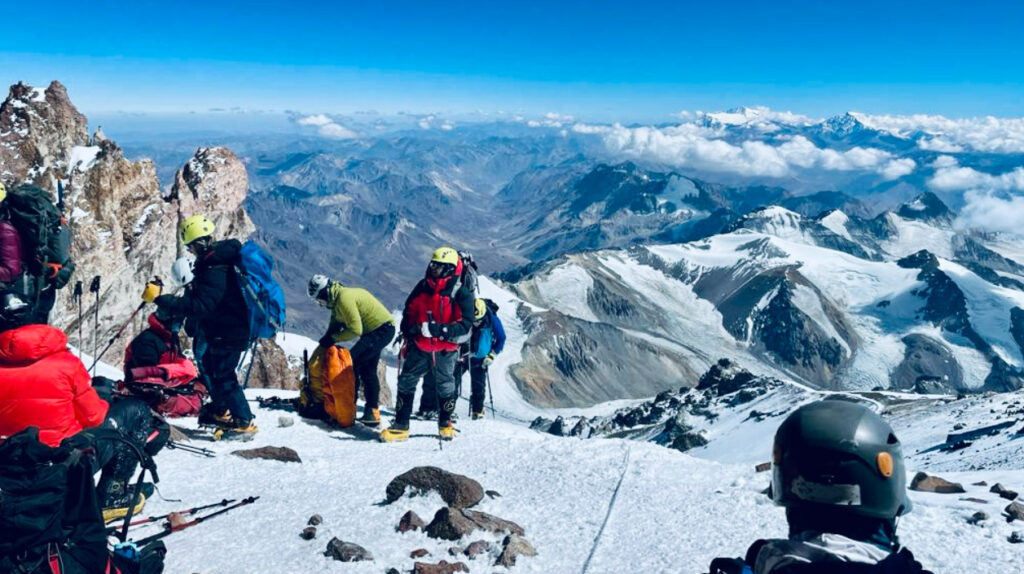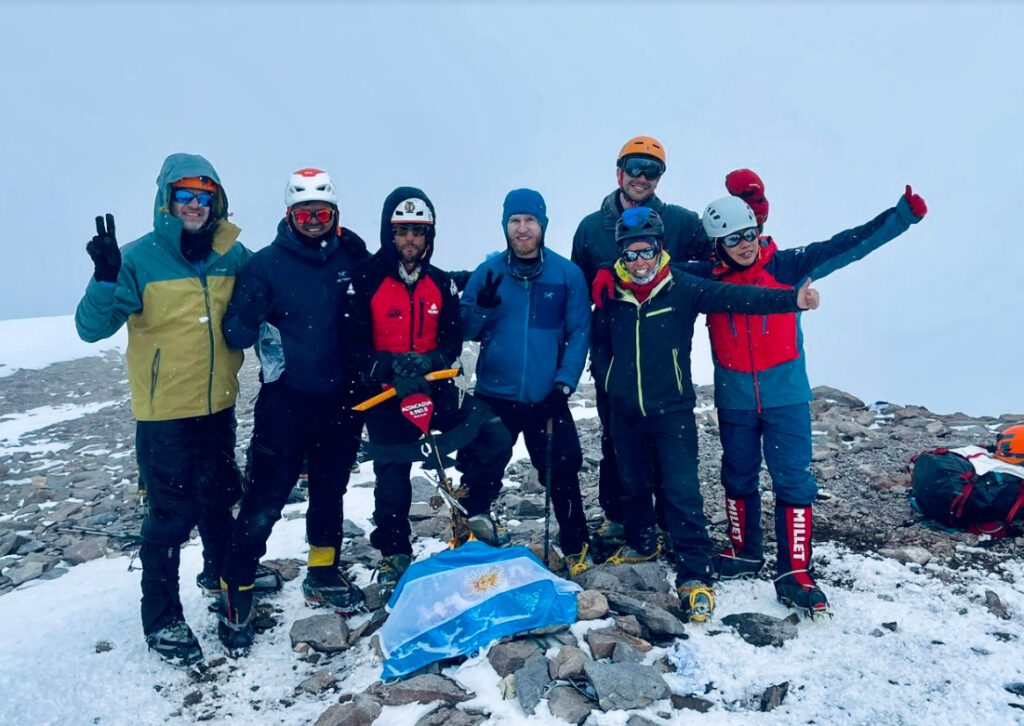After three years of dedicated Uphill Athlete training and COVID in the rearview, I was finally ready to take on a big expedition objective I first set sights on at the end of 2020 before Argentina had closed for the pandemic. In February 2020, I left behind running, bodybuilding, and powerlifting. I focused solely on the peaks I wanted to summit. I began working with Uphill Athlete’s training for mountaineering principles.
Having worked with Uphill Athlete coach Martin Zhor who set an FKT in 2019 on Aconcagua from Plaza de Mulas, the 18-day full itinerary for Mount Aconcagua was deemed a rapid ascent. Since it was only 12 days from entering the park on January 27, 2023, and summitting on February 7, hoping the acclimatization would go well would be risky, so we used a hypoxic tent for at least five nights a week.

The two big days of training a week were without the tent to maximize recovery, and we only trained with the low oxygen mask once at around 10,000 feet for about an hour.
It is terribly inconvenient to move around, and the mask gets sweaty. When I visited the Alps and stayed in huts at 9,000ft, I felt winded, and my heart was racing. Entering Penitentes and being at 9,000ft, I felt completely normal besides feeling a bit more winded doing the recovery jog, but my heart rate felt low, and sleeping felt like sea level.
Before entering the park and at 2700 meters / 8900 feet on January 26, I did a short 30-minute recovery jog and covered roughly 2 miles to help get the blood flowing and oxygen going. Earlier that day, we came from 750 meters / 2500 feet. It also helped fend off any remaining jetlag or dead-leg feeling.



Entering the park and reaching Confluencia camp was an easy 3-hour hike for me with very light packs that averaged around 5-10kg, mostly with food and water, as most of our gear was taken by mules directly from Plaza de Mulas and Confluencia camp. At this point, I was still nervous and cautious about the journey ahead and how my fitness would hold up. After all, my longest expedition was seven years ago to Mount Kilimanjaro, which was less than half the time.
After reaching Confluencia Camp, the next day was a mostly flat 8-hour round trip hike to Plaza de Francia, a popular viewpoint for the south face of Mount Aconcagua. Being the second day, I could feel the altitude at 13,871ft, although most of the end was flat. To make matters worse, I had quite the stomach sickness making it hard to hydrate and stay well. Needless to say, I was pretty worried about the rest of the trip and how hard this would be. This would end up being maybe the hardest day of the entire trip. It was the first day at a high altitude, and my stomach wasn’t doing well.
The next day I was feeling much better and off for the hike through Playa Ancha. This is the beginning when it starts relatively steep, but it would be almost another 8-9 hours to Plaza de Mulas. I had enough energy and air to talk, get to know my teammates, and help the time go by quickly. By the end, though, the endless path seemed to wrap around corner after corner and grew steep before Plaza de Mulas.
Still enjoying clear skies, we waited out and rested a couple of days at Plaza de Mulas before ferrying loads up to Camp 1 at 16,240ft. I was super anxious about this day in the morning because it would be the first time I carried roughly 30 lbs on me anywhere above 10,000ft (Mt. Rainier). When we started, I held the same pace as those with a full 45 lbs porter, and it felt much easier than anticipated. When finishing, my legs felt light and strong, with plenty of reserves. Going downhill was much less fun, leaving me slightly sore in Plaza de Mulas. That might be my technique, which is much harder to train for when living on flat terrain. Still, I was much less sore than in the Alps or previous climbs. Certainly, the training was paying off well.

The climbs to Camp 2 at 17,715ft and Camp 3 at 19,585ft were much like the load I carried to Camp 1. Despite having nearly 35lbs/16kg, the load felt light in my AMG 105 pack, and I finished the climbs with fresh legs despite some neck soreness (probably posture-related). I also set my tent up at each high camp and disassembled them in the morning, which meant I needed to have energy reserved if not using a porter. We had two days to rest at Camp 2 due to the bad weather, but we moved up to Camp 3 and started the summit the next day.



Images above: Sunrise at Independencia; Canaleta and the final steep section before the summit; This view on the summit day upon looking down from where the Caves are.
Above is the sunrise at Independencia, and I felt great. When I started, I didn’t have enough time, and my warm hat was letting my forehead freeze, my poles weren’t extended, the gaiters weren’t fitting right, and I didn’t drink enough water, but I pushed on with the group to fix everything at our first stop.
This is where having extra physical fitness is good. I had to leave my comfortable pace to adjust the gear troubling me. Nevertheless, I was feeling great.
Zooming in, you can see the people becoming smaller and smaller. I felt great through the Canaleta, one breath in with a right footstep and one out with a left footstep. I was on the guide’s heels the entire time, with no sign of stopping. I could feel myself becoming more hypoxic with glowing vision and some auditory hallucinations, but nothing that scared me into thinking I needed to go down. I still had plenty of energy and knew I would make it down without an issue.
After this, the weather turns nasty and into a full blizzard. The 10 lbs of water and snacks I was carrying weren’t much.
We were roughly 5-6 hours to summit, and I still felt light and strong. It’s a good feeling when your legs still aren’t heavy.
The first hour in the morning, I knew I would make it once the sun came up, and I would just have to be patient, or else the next eight hours would feel like a drag. It went by quickly, and I couldn’t believe it had been from 5 AM to 2:00 PM when we reached the summit!
It was a white view at the summit at 2:15 PM on February 7th. Five of us made it here, one more a few hours later, and another three had to go back down and left the expedition sadly. One climber, unfortunately, passed away, fighting to come up.
While descending, we encountered knee-high snow, drank all of our water, ate all of our food at the Caves, and kept pushing down until we reached camp safely. It took us another 5 hours before we could reach camp. At that point, all I wanted to do was sleep. Coming downhill is, and always has been, much harder than going uphill. Thankfully, unlike past trips, going downhill after the summit and the next day from Camp 3 to Plaza de Mulas left my legs feeling pretty tired and weak, but without limping and any sudden collapsing with my legs giving out. It has happened to me before. Perhaps the more descents I wrack up, or the more dynamic muscular leg endurance I do, downhill soreness and weakness become less of an issue along with technique.

My half-frozen face, after summitting during a whiteout.
In conclusion, Aconcagua’s Normal Route with a 12-day park entrance to the summit wasn’t the “next level” of mental and physical hardening I had imagined. I took many more precautions than most, and I think the hypoxic tent helped more than I will ever know, especially in my previous trip in August 2022 to the Alps. The hardest points were doing the Plaza de Francia viewpoint acclimatization hike while I was sick and the last 40 minutes of an expedited pace to Camp 2 because it began snowing. I burned through many reserves, with the weight moving much faster than the previous few hours so we could get to camp to beat the bad snow and weather coming in.
At this point, it wasn’t the fitness aspect but everything else, like the cold, the sun, the bathroom situation, and being away from friends and family, making the trip much harder.
I have gained much more real expedition experience without using porters for my loads and tent and experienced loss in the mountains that will harden me and give me great life lessons.
If I had to rate it, I would say 6 out of 10 Rate of Perceived Exertion for the whole trip is good as an average, while sometimes it was much higher or lower.
I hope more people see that you can have much more fun and a safe time by gaining extra fitness for the mountains.
Those that trained much less complained more with a more negative mood and often lost their balance or almost tripped. There is less overall anxiety, and I always tried to be a beacon of light for my group and explain what hypoxic feelings might be like. Eventually, I felt bad when my teammates asked how I was doing because, generally, the answer was always great. However, some mornings at Camp 2 and Camp 3, I woke up with a headache that dissipated after a few hours and some water. I didn’t want to be the fit smug athlete, but I had trained hard, prepared as I could, and stayed safe because of it.

View on the traverse after summitting Aconcagua — just a total whiteout, maybe 10-15 meters visibility.

